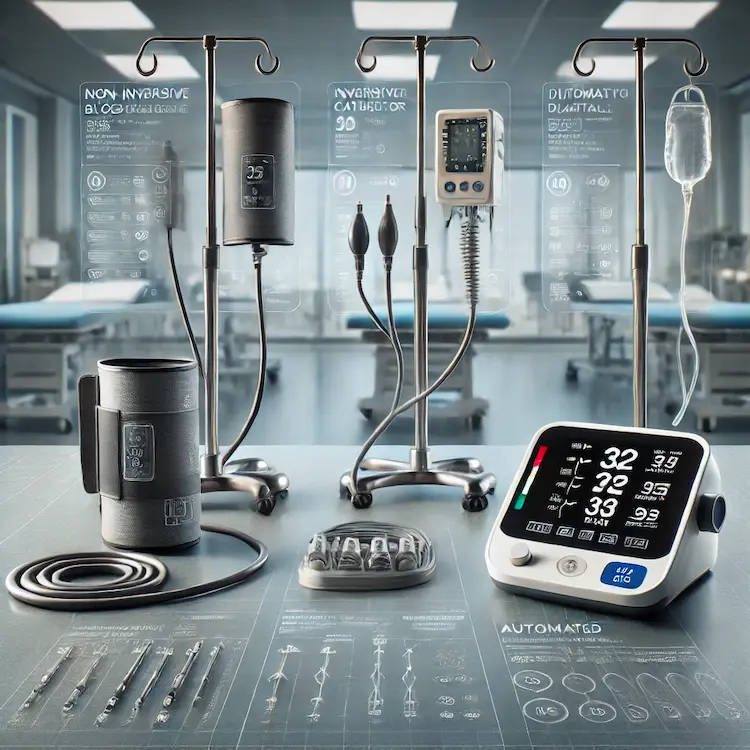Blood pressure monitoring is a critical component of patient care in Intensive Care Units (ICUs), providing essential data for managing critically ill patients. Accurate and continuous monitoring enables healthcare professionals to make informed decisions, ensuring timely interventions and improved patient outcomes.
In the ICU, patients often experience unstable hemodynamic conditions due to severe illnesses or injuries. Continuous blood pressure monitoring allows for the early detection of hypotension or hypertension, facilitating prompt treatment to prevent organ damage. Accurate monitoring is vital for titrating medications, managing fluid therapy, and assessing the effectiveness of interventions. Subtle changes in blood pressure can indicate clinical deterioration, making vigilant monitoring indispensable.
Two primary methods are employed for blood pressure measurement in ICUs: invasive and non-invasive techniques.
This method involves the insertion of a cannula into an artery, typically the radial or femoral artery, connected to a pressure transducer system. IBP provides real-time, beat-to-beat blood pressure measurements, offering high accuracy essential for managing hemodynamically unstable patients. However, it carries risks such as bleeding, infection, and thrombosis.
NIBP utilizes an inflatable cuff, usually placed around the upper arm, to intermittently measure blood pressure using oscillometric techniques. While safer and easier to implement, NIBP may be less accurate in certain clinical situations, such as during patient movement or in cases of severe hypotension. Studies have shown discrepancies between NIBP and IBP measurements, particularly during hypotensive episodes.

Advancements in medical technology have led to the development of Continuous Non-Invasive Arterial Pressure (CNAP) monitoring devices. CNAP provides continuous blood pressure readings without the need for arterial cannulation, reducing the risk of complications associated with invasive methods. However, the accuracy of CNAP devices can be affected by factors such as patient movement and peripheral vasoconstriction.
In the Philippines, hypertension is a significant public health concern. A nationwide blood pressure screening study revealed that almost half of the participants (44.9%) were hypertensive. Of these, 53.9% were aware of their condition, and 48.4% were on medication. Among those treated, only 43.5% had controlled blood pressure.
These statistics highlight the need for effective blood pressure monitoring and management strategies in both community and hospital settings, including ICUs. Implementing accurate monitoring techniques can aid in better hypertension control, potentially reducing the burden on the healthcare system.
The choice between invasive and non-invasive blood pressure monitoring methods depends on the patient’s condition, required accuracy, and available resources.
| Method | Accuracy | Risk Level | Application |
|---|---|---|---|
| Invasive (IBP) | High | Higher risk due to invasiveness | Hemodynamically unstable patients requiring continuous monitoring |
| Non-Invasive (NIBP) | Moderate | Lower risk | Routine monitoring in stable patients |
| Continuous Non-Invasive (CNAP) | Variable | Lower risk | Patients needing continuous monitoring without arterial cannulation |
To enhance blood pressure monitoring in ICUs across the Philippines:
Training and Education: Healthcare professionals should receive regular training on the proper use of both invasive and non-invasive blood pressure monitoring equipment to ensure accurate measurements.
Equipment Maintenance: Regular calibration and maintenance of monitoring devices are essential to maintain accuracy and reliability.
Resource Allocation: Investing in advanced monitoring technologies, such as CNAP devices, can provide continuous monitoring options with reduced risk, especially in resource-limited settings.
Public Health Initiatives: Community-based blood pressure screening programs can aid in early detection and management of hypertension, potentially reducing ICU admissions related to hypertensive emergencies.
Accurate blood pressure monitoring in ICUs is crucial for the effective management of critically ill patients. Understanding the advantages and limitations of various monitoring methods allows healthcare providers to make informed decisions tailored to individual patient needs. In the Philippines, addressing the challenges of hypertension through improved monitoring practices and public health initiatives can lead to better patient outcomes and a more robust healthcare system.
Continuous and accurate blood pressure monitoring is vital in ICU settings for timely intervention.
Invasive methods offer high accuracy but come with increased risks, while non-invasive methods are safer but may be less precise.
Emerging technologies like CNAP provide alternatives that balance accuracy and safety.
In the Philippines, a significant portion of the population remains unaware of their hypertensive status, underscoring the need for improved monitoring and management strategies.
Implement regular training programs for healthcare professionals on blood pressure monitoring techniques.
Ensure routine maintenance and calibration of monitoring equipment to uphold measurement accuracy.
Explore the adoption of CNAP devices to enhance continuous monitoring capabilities in ICUs.
Strengthen community outreach programs to increase awareness and early detection of hypertension.